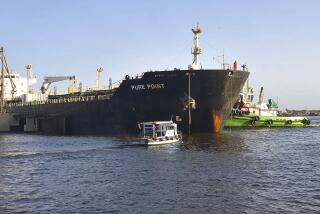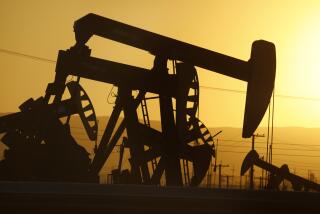Oil Prices Still Higher Than Estimated Costs
- Share via
Falling oil prices have caused severe problems for many segments of the energy industry, but analysts and industry executives say prices would have to dip below $10 a barrel to make most oil production a money-losing proposition.
And Saudi Arabia, the producer that triggered the price collapse that Tuesday reached the $15-per-barrel range, could make money at prices below $2.
The Saudis, with the biggest oil reserves and most prolific wells of any producing nations, represent the low-cost extreme in a world oil economy that until recently has been controlled by price fixing, both by individual governments and by the 13-member Organization of Petroleum Exporting Countries.
Only when OPEC lost its dominance did supply and demand begin to freely determine oil prices, and since 1981 those prices have been declining. But economists say that even with the 50% plunge since late November, prices remain far above the cost of production.
While oil producers aren’t eager to divulge such cost figures, one recent study given credence within the industry estimates that there is enough oil available at a production cost of $4 per barrel or less to supply two-thirds of the free world’s current demand.
The study by economists at Texas Eastern, a Houston oil and gas producer and pipeline firm, defines “production costs” as the cost of getting oil to the surface and paying taxes on it.
As such, it doesn’t include the costs of finding the oil to start with, putting a drilling rig in place, transporting the oil by pipeline or tanker and then turning it into gasoline, heating oil or other products at a refinery.
A sophisticated offshore drilling platform, for instance, can cost upwards of $100 million. Finding costs cited by major oil producers averaged from $7 to $10 per barrel in 1981-84, and it cost less adept firms $20 a barrel or more. A tanker trip from the Persian Gulf to East Coast U.S. ports can add $2 to the cost of a 42-gallon barrel of oil, depending on the size of the tanker.
However, the out-of-pocket cost of daily production is the break-even point below which most producers would probably “shut in” production, or cap the well and wait for higher prices.
“Economic theory says if you make a penny on a barrel of oil, you would go ahead and produce it,” said William Hermann, chief economist at Chevron in San Francisco. “Most of what we’re seeing produced today we will continue to see produced, down to maybe $10 a barrel.”
The daily cost of producing oil is a function of how deep the oil is, how many barrels per day are generated, whether it “flows” up the drilling column or must be pumped, how advanced the drilling technology is and other factors.
U.S. production is among the costliest, the Department of Energy says, because the wells are typically low-volume producers. The average U.S. oil well produces 15 barrels a day, while Persian Gulf wells--relatively costly to drill--generate thousands of barrels daily.
Britain’s North Sea oil fields were among the costliest to find and develop. The offshore platforms were expensive to build and put in place, and the drilling technology dramatically increased the initial investments.
Engineering Feat
“You don’t just drop a drill into some sand. It’s an amazing engineering feat,” said Daniel Yergin, president of Cambridge Energy Research Associates, a consulting and research firm.
Yet, once the rigs are operating, a DOE economist said, “the high flow rates make the North Sea a better economic proposition than most of the Lower 48,” referring to the U.S. contiguous 48 states.
The Texas Eastern study put the production costs in the North Sea fields at anywhere from $4 to $8 per barrel. That was supported by a recent study by brokers Wood MacKenzie & Co. of Edinburgh, Scotland, which said North Sea output would hardly be disrupted until market prices slumped below $5 per barrel.
Analysts say production costs in most major producing nations are driven lower by taxation formulas that typically reduce tax rates as prices fall.
The study by Texas Eastern economist L. J. Deman, done in mid-November before the recent price collapse, established an oil supply curve that indicated that oil should have been “economically priced at $8 to $10 per barrel.” But the low-cost OPEC producers, then holding back on production, “allowed oil demand to intersect the supply function at roughly $24 per barrel.”
The study estimated that “relatively minor production increases would cause oil prices to topple toward the $16-per-barrel plateau,” which is what Saudi Arabia subsequently caused to happen.
The question remains how far prices will fall. While the cost of production is the theoretical point at which wells would be capped and the oil glut would thus subside, such concerns as meeting contracts and maintaining market share could prompt some producers to continue pumping oil at a loss.
“Prices might even have to fall below lifting costs before significant volumes would be shut in,” the study concluded.
CRUDE OIL PRODUCTION COSTS Estimates per barrel in key fields Persian Gulf . . . . .. . .Under $2 North Sea . . . . . . . . . $4 -- $6 Alaskan North Slope . . . . $4 -- $6 California . . . . . . . . $4 -- $13
More to Read
Sign up for Essential California
The most important California stories and recommendations in your inbox every morning.
You may occasionally receive promotional content from the Los Angeles Times.










